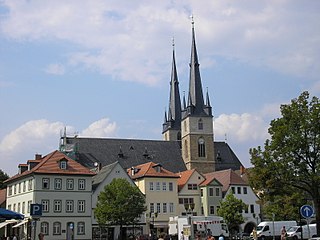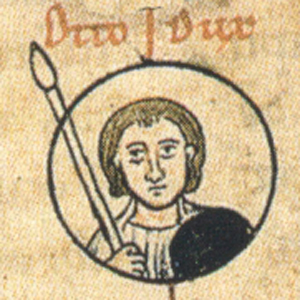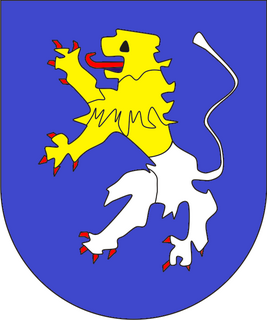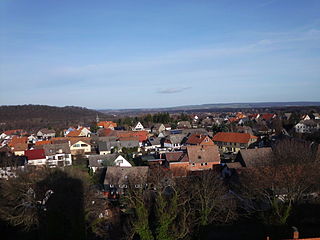
Henry the Fowler was the Duke of Saxony from 912 and the King of East Francia from 919 until his death in 936. As the first non-Frankish king of East Francia, he established the Ottonian dynasty of kings and emperors, and he is generally considered to be the founder of the medieval German state, known until then as East Francia. An avid hunter, he obtained the epithet "the Fowler" because he was allegedly fixing his birding nets when messengers arrived to inform him that he was to be king.

The Ottonian dynasty was a Saxon dynasty of German monarchs (919–1024), named after three of its kings and Holy Roman Emperors named Otto, especially its first Emperor Otto I. It is also known as the Saxon dynasty after the family's origin in the German stem duchy of Saxony. The family itself is also sometimes known as the Liudolfings, after its earliest known member Count Liudolf and one of its primary leading-names. The Ottonian rulers were successors of the Germanic king Conrad I who was the only Germanic king to rule in East Francia after the Carolingian dynasty and before this dynasty.

The Duchy of Saxony was originally the area settled by the Saxons in the late Early Middle Ages, when they were subdued by Charlemagne during the Saxon Wars from 772 and incorporated into the Carolingian Empire (Francia) by 804. Upon the 843 Treaty of Verdun, Saxony was one of the five German stem duchies of East Francia; Duke Henry the Fowler was elected German king in 919.

Saalfeld is a town in Germany, capital of the Saalfeld-Rudolstadt district of Thuringia. It is best known internationally as the ancestral seat of the Saxe-Coburg and Gotha branch of the Saxon House of Wettin, which was renamed the House of Windsor during their British reign in 1917.

The Kyffhäuser (German pronunciation: [ˈkɪfˌhɔɪ̯zɐ], sometimes also referred to as Kyffhäusergebirge, is a hill range in Central Germany, shared by Thuringia and Saxony-Anhalt, southeast of the Harz mountains. It reaches its highest point at the Kulpenberg with an elevation of 473.4 metres. The range is the site of medieval Kyffhausen Castle and the 19th century Kyffhäuser Monument; it has significance in German traditional mythology as the legendary resting place of Emperor Frederick Barbarossa.

The Unstrut is a river in Germany and a left tributary of the Saale.
The First Battle of Langensalza was fought on 9 June 1075 between forces of King Henry IV of Germany and several rebellious Saxon noblemen on the River Unstrut near Langensalza in Thuringia. The battle was a complete success for Henry, resulting in the subjugation of the Saxons shortly before the Investiture Controversy commenced. In Germany the battle is known as the Schlacht bei Homburg an der Unstrut, after a nearby Kaiserpfalz and monastery.

Otto, called the Illustrious by later authors, a member of the Ottonian dynasty, was Duke of Saxony from 880 to his death.

Pleissnerland, Pleissenland or the Imperial Territory of Pleissenland was a Reichsgut of the Holy Roman Empire, which meant that it was directly possessed by the respective elected King of the Romans or Emperor. It was named for the Pleiße River, and was located in what is now the border region between the German states of Thuringia and Saxony south of Leipzig, including the towns of Altenburg, Chemnitz, Zwickau and Leisnig.

Otto I, called Otto of Worms, a member of the Salian dynasty, was Duke of Carinthia from 978 to 985 and again from 1002 until his death.

The history of Saxony began with a small tribe living on the North Sea between the Elbe and Eider River in what is now Holstein. The name of this tribe, the Saxons, was first mentioned by the Greek author Ptolemy. The name Saxons is derived from the Seax, a knife used by the tribe as a weapon.

Vienenburg is a borough of Goslar, capital of the Goslar district, in Lower Saxony, Germany. The former independent municipality was incorporated in Goslar on 1 January 2014.

Gertrude of Sulzbach was German queen from 1138 until her death as the second wife of the Hohenstaufen king Conrad III.

Memleben Abbey was a Benedictine monastery in Memleben on the Unstrut river, today part of the Kaiserpfalz municipality in Saxony-Anhalt, Germany. The convent, now ruined, was established by Emperor Otto II and his consort Theophanu about 979.
Werlaburgdorf is a village and a former municipality in the district of Wolfenbüttel, Lower Saxony, Germany. Since 1 November 2013, it is part of the municipality Schladen-Werla.

Tilleda is a village and a former municipality in the Mansfeld-Südharz district, in the German state of Saxony-Anhalt. Since 1 July 2009, it has been part of the town Kelbra. Tilleda is located at the northern rim of the Kyffhäuser mountain range with the Kyffhäuser Monument, located in neighbouring Thuringia. The population is about 900.

Quedlinburg Abbey was a house of secular canonesses (Frauenstift) in Quedlinburg in what is now Saxony-Anhalt, Germany. It was founded in 936 on the initiative of Saint Mathilda, the widow of the East Frankish King Henry the Fowler, as his memorial. For many centuries it and its abbesses enjoyed great prestige and influence.

Otto I, traditionally known as Otto the Great, was East Frankish king from 936 and Holy Roman Emperor from 962 until his death in 973. He was the oldest son of Henry I the Fowler and Matilda.

The Hassegau was a medieval shire (Gau) in the Eastphalia region of the Duchy of Saxony. It was located in the duchy's southeastern corner; confined by the Saale river to the east and its Unstrut and Wipper tributaries to the south and north. Its most important town was Merseburg. In present-day borders, it is in the southeastern part of Saxony-Anhalt.

The Saxon Rebellion or Rebellion of the Saxons, also commonly called the Saxon Uprising, refers to the struggle between the Salian dynasty ruling the Holy Roman Empire and the rebel Saxons during the reign of Henry IV. The conflict reached its climax in the period from summer 1073 until the end of 1075, in a rebellion that involved several clashes of arms.


























